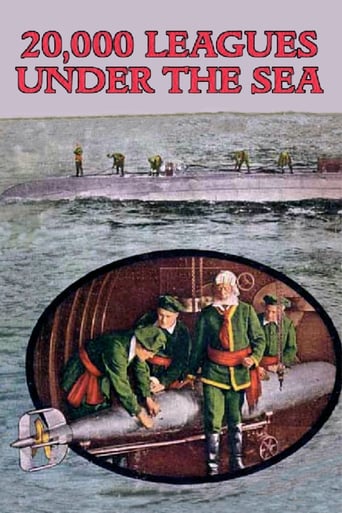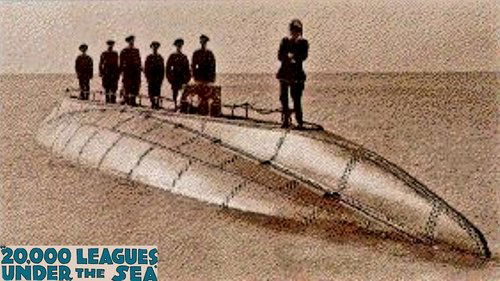


People are voting emotionally.
... View MoreThe biggest problem with this movie is it’s a little better than you think it might be, which somehow makes it worse. As in, it takes itself a bit too seriously, which makes most of the movie feel kind of dull.
... View MoreIt really made me laugh, but for some moments I was tearing up because I could relate so much.
... View MoreA terrific literary drama and character piece that shows how the process of creating art can be seen differently by those doing it and those looking at it from the outside.
... View MoreIt's fun to watch an old silent movie and imagine what it must have been like for people watching it back then. In this case, we have what must have been a blockbuster of the first water (pun intended). It includes a lot--and I mean a LOT--of underwater filming, which apparently hadn't been done before. In this way, millions of people would have gotten their first look at a world they'd never seen before. For the Nautilus they used a real submarine, which compared to later depictions is pretty basic but still must have had a strong impact at the time.The plot was a reasonably faithful version of the original book, though as usual they took a few liberties. This movie included a back story of where Nemo came from and why he chose the life he leads. As in the original book, Nemo is a Muslim from the Indian subcontinent--something many other film adaptations didn't seem to have the guts to do.The characters of Nemo and the princess are well and sympathetically portrayed. As you'll have with the silent medium, personality and feelings can be efficiently portrayed with a mere expression or gesture. The princess in particular is established as a charming and lovable character, the kind you could fall in love with and want to take care of the rest of your life. When one of the castaways tries to force himself on her, we find ourselves hating the loathsome blackguard and cheering when he gets his just deserts.So in general, when viewed through contemporary eyes we have a cracking good story with good character development, along with some revolutionary effects in the underwater photography. A masterpiece! But when seen through modern eyes...oh, dear. Inevitably, there are facets of the film that have not aged at all well. The interminable underwater scenes, though they must have been mind-blowing at the time, slow the pace badly, and compared to what we see every day on TV and the Internet the images are very blurry and indistinct. And, although they portrayed Nemo and the princess as Indian Muslims, they clearly used Western actors in black-face, which tends to wrinkle noses these days.And Nemo's costume! His coat of indeterminate colour with its white boarder, along with his obviously fake white beard, makes him look like Santa Claus in black-face. Surely they could have done better, even at the time? There are a few silent movies that have stood the test of time and can be appreciated by modern audiences--The Battleship Potempkin comes to mind--but this is not one of them. I would not, for example, try to show it to small children as they would be bored out of their skulls. Still, if you're one of those lucky people who is able to project themselves into the past and see an old movie through the eyes of the time, it's well worth a look.I really wanted to give this movie two ratings: a 10 for what it achieved at the time, and, say, a 3 for it's overall objective quality, but they don't let you. So, I gave it a 9, which is honest.
... View MoreThis screen adaptation of Jules Verne's novel seems to have been timely. Two recent innovations changed the story's relevancy. The film was released in 1916, when German U-Boats were showing the effectiveness of submarines in war, including the sinking of the Lusitania. Verne's science fiction had only recently become more fully realized. Additionally, deep sea travelling was to be exploited by science. Indeed, some of the best sequences in this film are just of fish and sharks in the marine gardens as the characters look through Captain Nemo's magic window. Another invention, the motion-picture underwater photography by the Williamson brothers allowed for Verne's fiction to be more fittingly portrayed with cinema. Certainly, this was a remarkable effect for the art form in 1916, and I think the underwater scenes remain the best parts of this film, with the exception of the cheesy octopus attack.Above water, the plot is plodding and confused. Unfortunately, the filmmakers tried to combine Verne's "Twenty Thousand Leagues Under the Sea" with his sequel to it, "The Mysterious Island". Consequently, through most of the photoplay, there are two parallel narratives loosely and convolutedly connected. Nemo is also transformed into a dark-skinned Muslim and his vengeful mission is changed, and a lengthy and foolish epilogue is added to make sense of the hodgepodge. The science-fiction parts faithful to the title novel are superior to and mix poorly with the added-on exoticism. In addition, the acting is dated. On the other hand, the shots of fish, sharks, the submarine and the diving suits are straightforward and retain interest especially due to the age and precedence.
... View MoreMonday November 2, 7pm, The Paramount, Seattle "Slowly, silently, it rises from unfathomable depths." A French scientist leads an expedition sent to find and destroy a gigantic, menacing sea monster. He discovers instead a dark, vengeful anti-hero that controls the "monster" and complications ensue.The third motion picture (American Mutoscope & Biograph 1905, Georges Méliès 1907) based on Jules Verne's Vingt Mille Lieues sous Les Mers from his legendary Voyages Extraordiniares, Universal Film Mfg. Co's 20,000 Leagues Under the Sea (1916) is noteworthy for the technically astonishing underwater photography of John Ernest Williamson's Submarine Film Corporation. Produced by Carl Laemmle over a two-year period in the Bahamas, at Universal's Leonia, New Jersey and Universal City, California facilities, for a reported cost of $500,000 (roughly $100,000,000 today), the screenplay also incorporated elements of Verne's Mysterious Island. The technology of Williamson's "Photosphere" observation chamber, used to film encounters with undersea creatures, rivals the fictional science of Verne's novel and helped establish the fantasy-horror legacy of Universal Studios.
... View MoreThe 1916 version of 20,000 LEAGUES UNDER THE SEA is a perfect example of what can happen when a film relies primarily on special effects. In its day, it was widely celebrated as one of the first feature-length films to make use of underwater photography, and audiences thrilled to its scenes of coral reefs and sharks. But nowadays we're very used to seeing underwater photography, and of a quality that far surpasses that seen here. And the film has little else to offer.The story, of course, is based on the Jules Verne classic--but "based" is the operative word. About the only thing this film version has in common with the Verne novel is the title, a few character names, and a few basic concepts, so if you're expecting a faithful silent adaptation of the novel you're outta luck. In this version, a scientist (Dan Hanlon) and his party go in search of sea monsters and run afoul of the Nautilus, but they soon discover that Capt. Nemo (Allen Holubar) really isn't such a bad guy after all. There's a subplot about a "child of nature" (Jane Gail) who lives on a "Mysterious Island" and who has some mixed experiences with shipwrecked sailors stranded there--and before the whole thing ends we are flashed back to colonial India for an explanation of just who Capt. Nemo really is and how he got that way. In the process there is underwater photography aplenty, including a faintly hilarious attack on a sailor by a 1916 special-effects-octopus.The acting is extremely broad here, even for 1916, and Nemo's costume makes him look rather like a skinny Santa Claus gone bad. The Nautilus is uninspired and the cinematography is only so-so. Consequently, what audiences thrilled over in 1916 seems pretty clunky today. The film has not been well-reserved, nor has any attempt been made to restore it, and there isn't a single scene that isn't riddled with artifacts. This is really a film for die-hard silent film buffs rather than casual viewers, and even silent film buffs will probably find themselves hitting the fast forward more than a couple of times. Recommended as a historic artifact, but nothing more.Gary F. Taylor, aka GFT, Amazon Reviewer
... View More